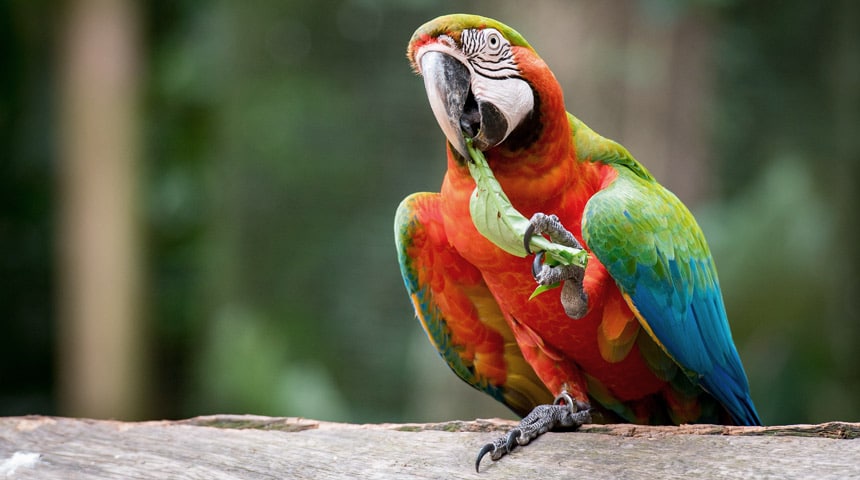
Various species of birds are kept as pets, and these originate from very diverse ecosystems such as the canopies of tropical rain forests, the Australian savannahs or the foothills of the Andes. Thus, they erquire diets that are as equally diverse, which can change with the seasons. It is not feasible to reproduce the natural diets of the birds we keep. It would not necessarily be recommended either, as the requirements for birds in a natural state are vastly different from those of birds in captivity.
In the last 20 years, avian nutrition research has supported the development of formulated diets also known as pellets. Formulated diets offer a balanced diet that is suited to the needs of our companion birds. Pellet-based diets also prevent birds from selecting their favorite foods (usually high-fat seeds), a very common practice.
Many pellet brands are available. Choose a brand that is well established and respected. Check the expiry date and smell the pellets for freshness on a regularly basis, as they can become rancid. Keep pellets in a cool & dry place or refrigerate them for prolonged freshness. Pellets are sold in various shapes and sizes; choose some that are most likely to suit the eating habits of your bird (small birds may prefer large pellets that they can hold). Ideally, pellets should not contain added coloring or additives. We recommend Harrison's, 'Tropican' by Hagen and Lafeber brands.
Pellets should make up 60-80% of the basic diet for most parrots. For some small parrots and parakeets, which are nearly exclusively seedeaters, we recommend a reduced pellet ration of about 50%. The remaining 50% should be made up of non-oleaginous seeds such as millet (sunflower seeds are high in fat and should be given sparingly).
The basic diet should be supplemented with a variety of fresh fruits and vegetables and healthy table food. Yellow and orange vegetables (squash, sweet potato, carrots, red peppers) and dark leafy green vegetables (cabbage, lettuce, arugula, herbs, etc...) are highly recommended. Berries, tropical fruits, pomegranates, apricots, oranges and kiwis are some examples of fruits that might be well appreciated by parrots. It is also important to vary the preparation of food items. They can be offered raw; a whole acorn squash into which treats are inserted through cut out windows becomes a foraging game, a source of physical activity as well as providing nutrients. Raw foods can be cut into strips and rolled into a 'bouquet' or a wrap, they can be cut into large chunks or tiny pieces distributed throughout the cage in several small feeding stations. Food items can also be cooked and prepared in a soup, stew or puréed. The more interesting the presentation is for the bird, the more his natural curiosity is peaked and the more inclined he will be to try and appreciate different foods. Whole grains, whole grain products and legumes are healthy carbohydrate options but should be given in moderation to birds with a tendency to become overweight. Animal protein can also be given in limited quantities in the form of fish, eggs, and lean meat. Table food perishes quickly and should not be left in a cage longer than 4 hours. Avocado, rhubarb and chocolate are toxic.
Bird seeds can be offered, but should not exceed 20% of the basic diet for most parrots. It is also possible to offer a variety of nuts such as pecans, walnuts, and almonds. These are high in fat and must be given in limited quantities to birds with a tendency to become overweight.
Any diet change must be instituted very gradually and under surveillance. A bird may stop eating and become seriously ill if his diet is changed quickly. Please consult your veterinarian to build a diet plan that is targeted to your bird.
Julie Hébert, DVM, Dipl ABVP (avian practice)

